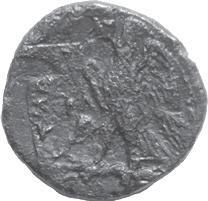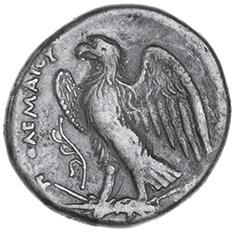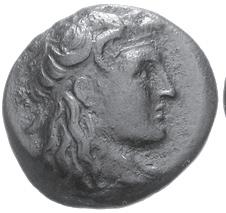
COINS OF THE PTOLEMAIC EMPIRE
THE
NUMISMATIC STUDIES 32
Contents
Preface v
Acknowledgements ix
Guide for Users xiii
Maps xv
Introduction
Ptolemy I Soter
Ptolemy II Philadelphus
Ptolemy III Euergetes
Ptolemy IV Philopator
Precious Metal Catalogue
Cleomenes of Naucratis
Ptolemy I Soter
Ptolemy II Philadelphus
Ptolemy III Euergetes
Ptolemy IV Philopator
Third-Century Provincial(?) Tetradrachms
Unattributable as to Reign (Ptolemy I–IV)
Late Additions to the Catalogues
Appendices
. Ptolemaic Precious Metal Hoards
. Additional Provenances of Precious Metal Coins
Bibliography
Concordance to Svoronos
Indices
. Remarkable Types in Gold and Silver
. Remarkable Denominations in Gold and Silver
. Remarkable Inscriptions on Gold and Silver
. Controls on Precious Metal Coins
Image Credits
Plates
PREFACE
Coinage of the Ptolemaic Empire updates the monumental work of the great Greek scholar J. N. Svoronos, Ta Nomismata tou Kratous ton Ptolemaion/Die Münzen der Ptolemaeer (Athens, ‒). Svoronos’ classification of the difficult Ptolemaic series was an extraordinary achievement. Its general outlines are still valid today, at least for the early Ptolemies, but inevitably there are errors of attribution and interpretation. The study of Ptolemaic coinage has made considerable progress in the century and more since Svoronos published his four volumes. For the coinage of the early Ptolemies the most important advances came in the areas of chronology, mint attribution, monetary policy, currency supply, and the economic role(s) of the coinage. We now have a solid grasp on the chronology of the successive coinages and reforms of Ptolemy I, as well as a clearer picture of the various currency reforms of Ptolemy II. The sequence of third-century Egyptian bronze issues is firmly established. Certain provincial bronze series have been reassigned so that the distribution of Ptolemaic mints is now better aligned with Lagid foreign possessions and involvements. Throughout the empire mint activity was probably always intermittent, and after the middle of the third century precious metal coinage was issued very infrequently. This pattern of production, along with other royal policies, contributed to the shortage of silver currency in Egypt in the later third century long discussed by papyrologists and economic historians. The record of Egyptian bronze hoards reflects a major demonetization of bronze currency near the century’s end that must be related to a fundamental accounting reform deduced from Egyptian documents by papyrologists and economic historians.
In its scope of coverage, Coinage of the Ptolemaic Empire conforms to the general pattern established by Svoronos: the main focus is on royal coinage issued in the names of Ptolemaic kings and family members, but the catalogues also include the provincial coinage of Judah under the Ptolemies, the municipal coinage of dynastic foundations, and selected coin issues of subject or allied cities that bear Ptolemaic portraits, types, or dynastic symbols. This scope is not precisely identical with the monetary production of the Ptolemaic empire. Although royal Ptolemaic coinage held a monopoly in the core of the empire, this monopoly was established at different times in different regions. The catalogues exclude the Alexander coinage produced by Cypriote and Phoenician mints in the diadochic period and the native Cyrenaican and Cypriote coinages struck in the early years of Ptolemaic domination. There is no evidence for closed currency markets in the more remote Lagid possessions in Asia Minor and Thrace, and Ptolemaic coins accounted for only a tiny fraction of the currency supply in these regions.
Svoronos’ Ta Nomismata tou Kratous ton Ptolemaion is a corpus listing individual specimens of each variety, in some cases many examples. The present work does not duplicate that enormous compilation but instead offers a type catalogue that draws on Svoronos and other scholarly publications, and also on commercial literature. This approach has not rendered Svoronos’ corpus obsolete; on the contrary, it will remain an
 Map . Ptolemaic Egypt.
Map . Ptolemaic Egypt.
PTOLEMY I SOTER
Satrap, –/ B.C.
King, late /early – B.C.
I. History of the Reign
Genealogy and Dynastic Chronology
Ptolemy, son of Lagos, was born in Eordea, Macedonia in the s or early s and was descended from Macedonian royalty through his mother, Arsinoe.1 A prominent officer of Alexander the Great, he was appointed satrap of Egypt and Cyrenaica after the conqueror’s death in June of .2 He assumed the royal title in the summer or autumn of , according to the Greek literary tradition.3 This version of events is supported by a Greek papyrus from Egypt.4 But another group of documents, including demotic papyri, dates his kingship from late to .5 As pharaoh of Egypt, Ptolemy was accorded the following titles, completing four of the five parts of the traditional Great Name:6
. Arr. Anab. .; Satyrus, FGrHist F ; P. Oxy. .. For the date of Ptolemy’s birth and for Arsinoe’s genealogy, see C. J. Bennett at www.tyndale.com/egypt/ptolemies/genealogy.htm. Ptolemy was later rumored an illegitimate son of Philip II (Curt. ..; Paus. ..). Collins () concluded that he was indeed illegitimate but was adopted by Lagos. . The precise date of Alexander’s death has been calculated from Babylonian documents as June by Depuydt (), pp. –. This supercedes the earlier calculations of Skeat (), p. ( June) and Samuel (), p. ( June).
. Diod. .; Plut. Dem. .; App. Syr. ; Just. .. See C. J. Bennett at www.tyndale.com/egypt/ptolemies/ genealogy.htm; Van Oppen (b), arguing that Porphyry (Eus. Chron. I [Schoene] ) can be made to harmonize with other Greek literary sources.
. P. Köln , , ll. –; Maresch in Gronnewald et al. (), pp. – with n. ; Lehmann (a). Herklotz (), p. , suggested that the discrepancy in the date of Ptolemy’s accession may indicate that it was problematic for the Egyptians to integrate a foreign ruler into the pharaonic system. This idea receives some support from the donation stela of Amenhotep, son of Khahor, dated to the fourth year of Ptolemy I, which shows a pharaoh making offerings to the Tanaite deities Amun, Mut, Khonsu, and Horus of Mesen, beneath empty cartouches, see Guermeur (), pp. ‒.
. Canon Ptol. at (year = November – November ); Marmor Parium (FGrHist F B ), (archonship of Euxenippos = July –July ). The latest Egyptian documents to name Alexander IV are P. dem Louvre and (Hathyr year = January– February ). For discussion of the complicated calculations, involving the Attic, Macedonian, Egyptian, and Julian calendars, and for assessment of the chronological hypotheses of various scholars, see C. J. Bennett at www.tyndale.com/egypt/ptolemies/genealogy.htm. Samuel (), pp. –, identified November – February as the probable date range and hypothesized that the actual date of accession was November , equivalent to Thoth, New Year’s Day of the Egyptian calendar. Grzybek (), pp. –, dated Ptolemy’s accession to Hathyr (c. January) based on an interpretation of the Pithom stela. Bennett, following Gruen (, pp. , , n.), thought it likely that Ptolemy assumed his kingship after thwarting Demetrius at Rhodes and dated the accession to spring , perhaps to Daisios (c. June), the anniversary of Alexander’s death. Some Egyptologists have suggested that Ptolemy may have styled himself basileus in / but did not seek formal recognition as pharaoh until /, but Bennett objected that the Marmor Parium, with its Greek orientation, would not have recorded Ptolemy’s pharaonic accession in preference to the beginning his basileia, if there had been a difference. . On pharaonic titulature, see Beckerath (); on the Ptolemaic adaptation of pharaonic titulature, see Tait (). Heinen (), p. n., considered it likely that Ptolemy was crowned at Memphis according to Egyptian rites.


Ptolemy’s care for his mortal remains.394 Alexander’s presence on the obverse of the coins—a position traditionally reserved for a god395—announced his apotheosis years before Ptolemy founded his official cult. His panoply of divine attributes suggests the nature of his divinity (Fig. .). These include the elephant headdress, whose lower part is articulated as an aegis tied around the neck, and a curling ram’s horn growing from his temple. According to conventional interpretation, the elephant headdress is a symbol of Alexander’s conquest of India, an association later reinforced by the addition of the mitra (headband) of Dionysus, the mythical first conqueror of India, or at least of the Orient.396 Indeed, some scholars have held that the elephant headdress itself is a Dionysian attribute and that the coin type depicts the apotheosis of Alexander as Dionysus.397 The ram’s horn is the horn of Ammon, recalling Alexander’s visit to the oracle of Zeus-Ammon at Siwah, where he was first recognized as a son of the god, and where his conquest of the world was predicted.398 The aegis is usually described as a sign of Zeus’ protection for his son.399 All of these interpretations require elaboration.
At the time of its introduction, the elephant headdress had to be perceived as a counterpart of the lion headdress of Heracles, whose image was widely disseminated on Alexander’s tetradrachms. The parallel implies that the elephant headdress too is a crown of indomitable courage, victory, and power, an emblem of world dominion and/ or earned divinity.400 The juxtaposition of the two heroes represented Alexander as the
. The coin type is related to the events of (and sometimes also to the cult of Alexander) by Zervos (), pp. –; Mørkholm (), pp. –; von Reden (), pp. –; Cavagna (), p. .
. Kroll (), pp. –.
. Schreiber (), p. ; Kuschel (), pp. –; Brown (), pp. –; Maritz (), p. . Dionysus’ conquest of Asia as far as Bactria is attested by Eur. Bacch. ll. –. Scholars who rely on literary sources deny an early identification of Alexander with Dionysus, e.g., Nock (), pp. –. Goukowsky () argued influentially that Alexander did not identify himself with Dionysus during his eastern campaign, and that the association was promoted by Ptolemy but only achieved widespread recognition after the Grand Procession of Ptolemy II, which he dated c. . On the mitra of Dionysus as a possible source of the royal diadem, see Meyer (), with earlier literature.
. Neuffer (), pp. –, followed by L’Orange (), p. , and a few others.
. Strab. .– (= FGrHist F ); Bosworth (); Kienast (), who argued that Alexander advertised the paternity of Zeus but regarded Ammon as an oracular god rather than as a divine father. Ephippus, FGrHist F reports that during his lifetime Alexander occasionally donned the horns of Ammon, as well as attributes of other deities and heroes including Artemis, Hermes, and Heracles (Zeus is notably absent from the passage).
. Grimm (), p. ; Stewart (), p. .
. Hadley (), pp. –; Zervos (), pp. –; Brown (), pp. –; Stewart (), pp. –; Bosworth (),
to the
Alexandria
PTOLEMY II PHILADELPHUS
/– B.C.
EGYPT
Coinage on System of Ptolemy I: Ï and Ï above Galatian Shield Series
Issues with the sign Ï were attributed to Cyprus by R. S. Poole, J. N. Svoronos, and D. H. Cox, but A. Davesne (Meydancıkkale, p. with n.) reassigned them to Alexandria based on the holdings of the Alexandria and Nicosia Museums. In addition Davesne (pp. –) noted the absence of these series from the Egypt before , and Phacous hoards (IGCH , ) and dated them between / and /. He derived the upper date from his metrological analysis and his assumptions of annual emissions and a regular rate of annual weight loss, a methodology not embraced here. C. Lorber (c, pp. ‒) identified irregular rhythms of production and proposed that episodes of intense mint activity should be correlated with military campaigns. The terminus ante quem for these series is the change of the reverse legend in /, from to . Svoronos (, Vol. , cols. and , Vol. , cols. –) suggested that the sign Ï abbreviated the epithet Soter. The two inner hastae of the sign are invariably straight, however, and the presence of cannot be confirmed.
Gold trichryson or triple stater (“pentadrachm,” c. 17.85 g): Diademed head of Ptolemy I r., sometimes with or other mark behind ear, aegis tied around neck, dotted border/ on l., on r., eagle with closed wings standing l. on thunderbolt, dotted border.
Silver stater (tetradrachm, c. 14.26 g): Types as preceding.
Silver drachm (c. 3.60 g): Types as preceding, but eagle with spread wings. Ï issue, perhaps 282 B.C.
C. Lorber (c, pp. ‒) tentatively dated this issue to the first year of the sole reign of Ptolemy II, when dynastic conflicts of at the court of Lysimachus provided an opportunity to deploy the Lagid fleet and to form the Ptolemaic sea empire with little risk of opposition. For the associated bronze coinage, see Vol. , B–B.
276. Gold trichryson or triple stater (“pentadrachm”): Ï in l. field.
Reference: Svoronos 547, pl. xiv, 1 [18 listed]; SNG Copenhagen 106.
Hoards: Hüseyinli (CH IX, 489), Davese and Yenisoğancı (1992), 57; 23 in Toukh el Garmous, 1905 (IGCH 1680).
277. Silver stater (tetradrachm) (sometimes with or pellet behind ear): Ï in l. field.
Reference: Svoronos 548, pl. xiv, 2 [16 listed].
Hoards: 5 in Eretria (IGCH 175), Picard (1979), 421–424, plus 1 in Newell’s record in ANS; Sophikon (IGCH 179), Svoronos (1907a), 932; Sounion, Attica (CH IV, 32); 2 in Corinth (IGCH 187), Noe (1962), 347–348; Sparta, 1908 (IGCH 181), Wace (1907/08), 81; 2 in Sögutlüdere (CH VIII, 246), Ashton, Arslan, and Dervișağaoğlu (1996), 8–9; 82 in Meydancıkkale (CH VIII, 308), Meydancıkkale 3732–3813; 2‒3 in Ora, 1947 (IGCH 1473), information courtesy of J. Olivier; 3 in Galatia (IGCH 1474 = Olivier, CT 6); 3 in Syria, 1981 (CH VII, 90 = CH VIII, 339 = EH I, 105), Meadows 308‒310; Saida, 1949 (IGCH 1586), Trésors 40.15; Tel Michal, 1977 (CH VII, 85 = CH VIII, 307 = CH IX, 498), Kindler (1977), 11; Hebron area, 1991 (CH VIII, 304 = EH I, 100), Meadows 29; 6 in Iraq al-Amir (CH IX, 497 = CH X, 268 = EH I, 96), Keen 49–54; 12 in Saqqara, 1968 (IGCH 1681 = CH IX, 684), Price (1981), 7–18; Near Alexandria, 1844 (CH VIII, 303); Rüppell, East Delta, before 1822, per Noeske (2006), p. 41.
Ï above Galatian Shield series, probably 275/4–c. 272 B.C.
Ptolemy II adopted an oval shield as his personal emblem. Many scholars have connected it with his suppression of a revolt of Gallic mercenaries in the army sent against Magas of Cyrene, probably in /. Ptolemy lured the Gauls to an island in the Nile and trapped them there to starve. The court poet Callimachus, Hymn IV (To Delos –), compared this action to Apollo’s defense of his Delphic sanctuary against the Gallic invaders of Greece in / and explicitly awarded Galatian shields to both the god and the king as symbols of their victories. The poet imputed cosmic significance to the twin episodes, calling the Galatians “late-born Titans” and implying that Ptolemy had saved his kingdom from chaos, one of the primary functions of an Egyptian pharaoh. The comparison to Apollo also evoked his Egyptian equivalent, the royal god Horus, who was responsible for the maintenance of Maat (cosmic and worldly order) and was especially associated with the suppression of revolts.
D. Salzmann () challenged this interpretation of the shield, drawing attention to its association with the Egyptian god Bes and with other deities in Graeco-Roman Egypt. He suggested an allusion to the court myth that Ptolemy I was exposed on a shield as an infant and nurtured by an eagle sent by his father, Zeus; the shield thus served Ptolemy II as a dynastic symbol implying his own divine descent and the legitimacy of his succession.
Like most symbols, the shield is probably polysemous. When associated with the portrait of Ptolemy II, as on the gold coinage of the Theoi Adelphoi (nos. – below), it naturally recalls the episode of the rebellious mercenaries. When associated with an eagle, as in the present series, it recalls the miraculous salvation of the infant Ptolemy.
With this series, the Alexandria mint introduced a new control system based on individual letters of the Greek alphabet, as opposed to the monograms and occasional symbols that had been used earlier. Svoronos (, Vol. , cols. ) interpreted the letters as regnal dates, expressed not according to the usual decimal system of numeration but rather with the letters of the alphabet representing a continuous series of numbers. This exceptional system inspired skepticism in M. J. Price (, p. ) and H. A. Troxell (). A. Davesne (Meydancıkkale, pp. –) refuted it entirely by reporting die links among all of the principal control letters, some links involving as many as six letters. These patterns of linkage suggest that the control letters were employed simultaneously rather than successively. (However, contrary to the impression given by Davesne, his linkages do not account for all of the known control letters, some of which were not represented in the Meydancıkkale hoard.) Davesne estimated that the minting of this coinage required from one to four years and plausibly associated it with the First Syrian War (–). The bulk of the issue probably dates from just before the war, and production had probably ceased by the introduction of the Theoi Adelphoi gold coinage in or before (see below). The provenances of the tetradrachms and their associated bronzes (Vol. , B–BA) indicate that they also played a role in financing the Chremonidean War and perhaps later Ptolemaic interventions in Greece as well.
In addition to bronze coins associated with these precious metal issues (Vol. , B–BA), there was also a separate series of bronze diobols and obols marked with Ï above shield above _, with control letters between the eagle’s legs (Vol. , B–B).
No control letter
For the associated bronze coinage, see Vol. , B–B.
278. Gold trichryson or triple stater (“pentadrachm”): Ï above Galatian shield in l. field.
Reference: Svoronos 599 [2 listed].
279. Silver stater (tetradrachm): Ï above Galatian shield in l. field.
Reference: Keen (forthcoming), 55.
Hoards: Saida, 1949 (IGCH 1586), Trésors 40.17 (with upper control erased); Iraq al-Amir (CH IX, 497 = CH X, 268 = EH I, 96), Keen 55.
279A. Silver drachm: Ï above Galatian shield in l. field.
Reference: CNG 75, 23 May 2007, lot 558.
Control letter
For the associated bronze coinage, see Vol. , B–B, and cf. B–.
280. Gold trichryson or triple stater (“pentadrachm”): Ï above Galatian shield in l. field, between eagle’s legs.
Reference: Svoronos 558, pl. xiii, 1 [6 listed].
Hoard: Toukh el Garmous, 1905 (IGCH 1680).
281. Silver stater (tetradrachm): Ï above Galatian shield in l. field, between eagle’s legs.
Reference: Svoronos 559, pl. xiii, 8 [6 listed]. Multiple obverse die links with nos. 283 and 288; single obverse die links with nos. 295, 299, and 302.
Hoards: 9 in Meydancıkkale (CH VIII, 308), Meydancıkkale 3817, 3831, 3834, 3837, 3841–3842, 3848, 3858–3859; Saqqara, 1968 (IGCH 1681 = CH IX, 684), Price (1981), 19.
Control letter
For the associated bronze coinage, see Vol. , B.
282. Gold trichryson or triple stater (“pentadrachm”): Ï above Galatian shield in l. field, between eagle’s legs.
Reference: Svoronos 566, pl. xiii, 2 [8 listed].
Hoard: 6 in Toukh el Garmous, 1905 (IGCH 1680).
283. Silver stater (tetradrachm): Ï above Galatian shield in l. field, between eagle’s legs.
Reference: Svoronos 567, pl. xiii, 9 [10 listed]; SNG Copenhagen 107–108. Multiple obverse die links with nos. 281, 288, 299, and 302; single obverse die link with no. 295.
Hoards: Enna, Sicily, 1966 (IGCH 2232 = CH IX, 670), Burnett (1983), 158; 14 in Meydancıkkale (CH VIII, 308), Meydancıkkale 3814–3815, 3819, 3827, 3830, 3832, 3836, 3838–3839, 3844, 3849–3850, 3865–3866; Galatia (IGCH 1474 = Olivier, CT 6); Syria, 1981 (CH VII, 90 = CH VIII, 339 = EH I, 105), Meadows 311;











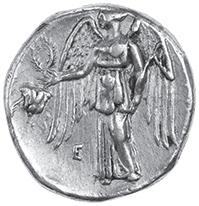











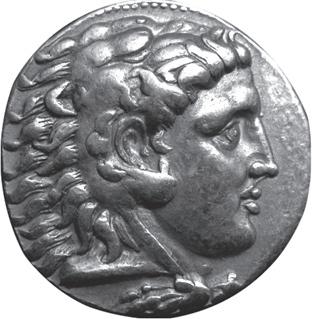






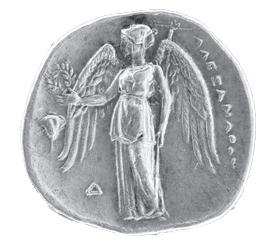












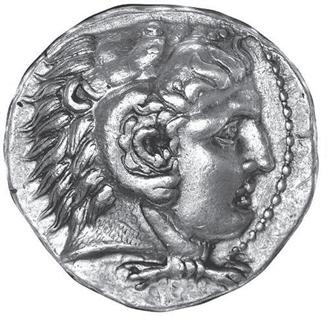










COINS OF THE PTOLEMAIC EMPIRE
NUMISMATIC STUDIES 32
THE AMERICAN NUMISMATIC SOCIETY NEW YORK
Contents
Preface v
Acknowledgements ix
Guide for Users xiii
Bronze Catalogue
Cleomenes of Naucratis
Ptolemy I Soter
Macedonia under Ceraunus and Meleager
Ptolemy II Philadelphus
Ptolemy of Telmessus
Ptolemy III Euergetes
Ptolemy IV Philopator
Appendices
. Ptolemaic Bronze Hoards
. Additional Bronze Provenances
Bibliography
Concordance to Svoronos Numbers
Indices
. Remarkable Types in Bronze
. Remarkable Inscriptions
. Controls
Image Credits
Plates
GUIDE FOR USERS
Coinage of the Ptolemaic Empire aspires to provide an historical overview of the production of Ptolemaic coinage. The catalogues are organized first by reign, then by region, then by mint. The individual issues are listed in the order in which they were struck, to the extent that their sequence can be determined.
While convenient for certain purposes, this presentation does not provide easy points of entry for a numismatist seeking to identify a coin in the hand, unless he or she is already fairly expert in the study of Ptolemaic coinage. Very few Ptolemaic coins declare explicitly which king authorized their emission, and even royal portraits can be deceiving, since they were sometimes posthumous.
If a Svoronos reference is already known, the fastest way to find the corresponding entry in CPE is to consult the concordance from Svoronos to CPE in the end matter. The end matter also includes indices designed to aid in coin identification. For precious metal coins there are indices of remarkable types, remarkable denominations, remarkable inscriptions, and controls; the first three are subdivided by metal, the last into unmarked issues, symbols, and finally letters and monograms. For bronze coinage there are indices of remarkable types, remarkable inscriptions, and controls. The latter are subdivided into unmarked issues; symbols; combinations of symbols, monograms, and/or letters; and finally letters and monograms. It is a matter of judgement to choose which index is most likely to lead to the rapid identification of a coin being researched. In general, however, remarkable types, denominations, and inscriptions are relatively uncommon, so that for most coins the index of controls is the only practical aid.
In many cases it has proved impossible to attribute coins to a specific mint city. Following a practice established in Seleucid Coins, groups of coins evidently issued by a single unidentified mint are listed together, and a number is assigned to the unknown mint. In Part I of Coinage of the Ptolemaic Empire, 42 such uncertain mints are enumerated, and in a few cases the mint numbers enable the association of precious metal and bronze coins that are catalogued separately in Volumes 1 and 2. The numbering of the uncertain mints should not be interpreted to mean that 42 distinct mints operated in different locations, in addition to the various mints whose locations are identified. The episodic nature of Ptolemaic coin production ensures that we often lack criteria for identifying coins that were minted in the same location at different times. Almost certainly some of the coins attributed to uncertain mints were struck at known mints, and it is equally likely that some uncertain mints with different numbers should be associated with one another.
A very short section at the end of the precious metal catalogues is devoted to coins which could not be assigned by reign. It is followed by an equally short list of addenda which came to the author’s attention so late in the production process that they could not be integrated into the main catalogues without disrupting the layout and pagination of the volumes.
Alexandria
Egyptian Series
PTOLEMY I SOTER
Satrap, –/ B.C.
King, late /early – B.C.
EGYPT
Bronzes with Short-Haired Alexander Bronze Weight Standard
Ptolemy’s first regular bronze coinage features types that associate it with the Alexander/Athena Promachos tetradrachms of his satrapy and the early years of his kingship. The thematic links include the mitra, which had been absent or inconspicuous on the earlier Alexander/Zeus tetradrachms, and the eagle on thunderbolt, which appears as a subsidiary symbol on the reverse of the Athena tetradrachms.
The values of Greek bronze denominations have been established quite persuasively for the Greek homeland and the Macedonian kingdom, see especially O. Picard (, pp. –) and C. Grandjean (, pp. –), with earlier bibliography cited. It is only reasonable to assume that the monetary system of Alexander the Great, based on an obol of eight chalkoi, was translated to the kingdoms of his successors. The face values proposed here and in subsequent sections generally follow A. Davesne (, pp. and ), except that the denomination of c. g is here identified as a hemiobol rather than a dichalkon.
In addition to provenances noted under individual catalogue entries, hemiobols and chalkoi of Egyptian Series were found in excavations at Alexandria, see Picard and Faucher (), ‒ and ‒.
Bronze hemiobol (13–20 mm, c. 4 g): Head of deified Alexander r., wearing mitra, with ram’s horn at temple and short hair/ on l., eagle with spread wings standing l.
Mean weight: 3.869 g, based on 9 specimens; see Wolf (2013).
Bronze chalkous (8–10 mm, c. 1 g): Types as preceding, but legend abbreviated or Ó.
Mean weight: 0.936 g, based on 41 specimens; see Wolf (2013).
Bronzes associated with Tetradrachm Issue of c. B.C.
The bronze coinage was very likely inaugurated in conjunction with a transitional tetradrachm issue (Svoronos ; Vol. , no. ) that immediately preceded the Athena Promachos series. This issue paired the enthroned Zeus reverse type with a restyled head of Alexander wearing a prominent mitra, and it was on this transitional issue that the eagle on thunderbolt symbol appeared for the first time. The transitional tetradrachm is control linked to the bronze coins B–B below.
In most recent literature the transitional tetradrachm is dated around , based on the chronology of G. K. Jenkins (, pp. –) and O. H. Zervos (; , p. ). C. C. Lorber (b) brought the evidence of Ptolemy’s earliest royal bronze coins to bear on the chronology of the tetradrachms. Although
some aspects of that paper require revision, a date of c. still appears probable for the transitional issue and the associated bronze coinage.
B4. Bronze hemiobol (15 mm): in l. field.
Reference: Svoronos Vol. IV, Addenda 30A [1 listed, Dattari]; CNG 39, 18 September 1996, lot 868.
Svoronos describes the Dattari specimen as portraying Alexander with features of Ptolemy I. The wellpreserved example sold by CNG shows a young man of ideal beauty, clearly Alexander and not Ptolemy.
B5. Bronze chalkous (10 mm): in l. field.
Reference: Svoronos 31, pl. ii, 9 [6 listed]; HistMusFrankfurt 9.
B6. Bronze chalkous (10 mm): in r. field.
Reference: SNG Copenhagen 32.
Bronzes associated with Alexander/Athena Tetradrachms, c. 311–c. 306 B.C. and perhaps later
B and B below share the controls of early Attic-weight tetradrachms of the Athena Promachos type. The remaining varieties cannot be associated with Egyptian tetradrachms of Attic weight, but many chalkoi exhibit control links to precious metal coins of later periods. Their legends naming Alexander as issuing authority would seem to be anachronistic once Ptolemy’s name and royal title began to appear on a new generation of bronze hemiobols portraying Alexander with long hair (Series , B–B). Yet the reducedweight Athena tetradrachms continued to be issued in Alexander’s name even after Ptolemy assumed the diadem and it is assumed here that chalkoi in the name of Alexander were produced from time to time to supplement the hemiobols issued in Ptolemy’s name (see B–B, B, B, B). Such an arrangement of the material implies an overlap between Series and . This seems plausible, because the chalkous and its characteristic types survived Ptolemy’s final currency reform as the smallest piece of an expanded system of six bronze denominations issued in the name of King Ptolemy (see B below).
The alternative to positing later dates for these chalkoi (B–B, B, B, B) is to assume that the control links reflect the reuse of particular controls in different periods. There are a few control links between precious metal coins belonging to different periods, but the controls involved are mostly banal or else their function changes from marking issues to marking series.
B7. Bronze chalkous (11 mm): (or ) in l. field.
Reference: Malter II, 23–24 February 1978, lot 3.
Assuming that the control is poorly engraved, this bronze is control linked to the first silver coinage with the Athena Promachos reverse, Svoronos 32–35 (Vol. 1, nos. 40–44), dated c. 311 B.C.
B8. Bronze hemiobol (18 mm): in l. field, in r. field.
Reference: Svoronos 46, pl. ii, 25 [8 listed].
Provenanced find: At least 2 in Alexandria excavations, Picard and Faucher (2012), 26‒27.
This bronze is control linked to a gold stater of Alexandrine type and to tetradrachms and drachms with the Athena Promachos reverse, Svoronos 44–45 (Vol. 1, nos. 49–52), dated c. 309 B.C. Many drachms of this issue are plated (subaerata) and of inferior style. The bronzes, too, exhibit a tendency to barbarous style.
B9. Bronze chalkous (8–10 mm): Anepigraphic, with no controls.
Reference: Svoronos 28, pl. ii, 35 [6 listed].
B10. Bronze hemiobol (19 mm): No controls.
Reference: Svoronos 57, pl. ii, 30 [1 listed, Osnabrück].

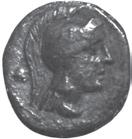
Cleomenes of Naucratis and/or Ptolemy I as Satrap
































